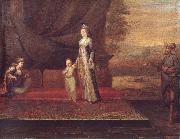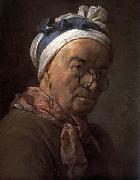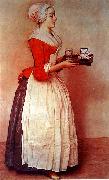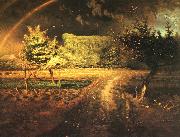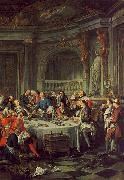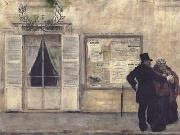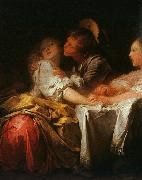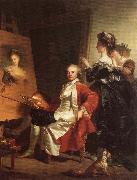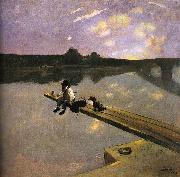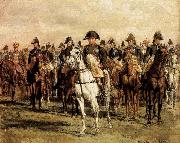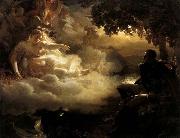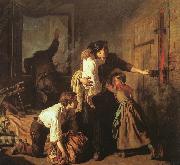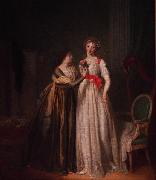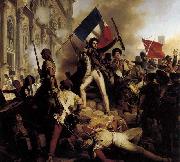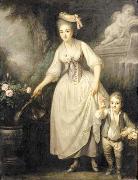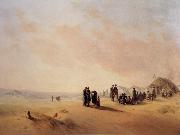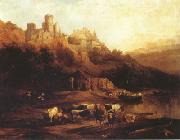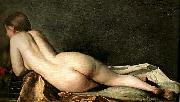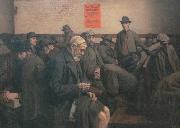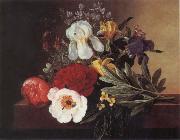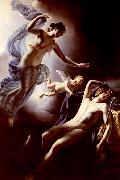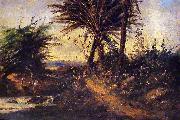|
|
|
|
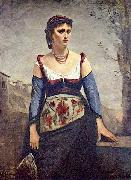 |
Jean-Baptiste-Camille Corot
|
|
was a French landscape painter and printmaker in etching. Corot was the leading painter of the Barbizon school of France in the mid-nineteenth century. He is a pivotal figure in landscape painting and his vast output simultaneously references the Neo-Classical tradition and anticipates the plein-air innovations of Impressionism.
|
|
|
|
|
|
|
|
|
|
|
|
 |
Jean-Francois Millet
|
|
Jean-François Millet (October 4, 1814 - January 20, 1875) was a French painter and one of the founders of the Barbizon school in rural France. Millet is noted for his scenes of peasant farmers; he can be categorized as part of the naturalism and realism movements.
|
|
 |
Jean-Francois Portaels
|
|
(3 April 1818 - 8 February 1895) was a Belgian orientalist painter and director of the Academie Royale des Beaux-Arts in Brussels.
Portaels was born in Vilvoorde. His father, a rich brewer, sent him to study at the Royal Academy, whose director, François Navez, took him on soon after in his own workshop. About 1841 Portaels went to Paris, where he was well received by Paul Delaroche.
The Rose VendorAfter his return to Belgium, he won the Grand Prix de Rome in 1842. He then travelled through Italy, Greece, Morocco, Algeria, Egypt, the Lebanon, Judaea, Spain, Hungary and Norway. On his return to Belgium in 1847 Portaels succeeded H. Vanderhaert as Director of the Academy in Ghent. In 1849 he married the daughter of his first teacher, Navez, and in 1850 he settled in Brussels; but when he did not get the post of director of the Brussels academy, and wished, nevertheless, to carry on teaching as his father-in-law had done, he opened a private studio-school, which became one of great significance in the development of Belgian art. Once more he went on his travels, spending time in Morocco; he returned to Brussels in 1874, and in 1878 became Director of the Academie Royale des Beaux-Arts which had so long been the object of his ambition. He died in Schaerbeek.
|
|
|
|
|
|
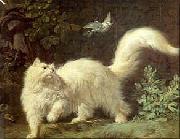 |
Jean-Jacques Bachelier
|
|
(1724 - 1806) was a French painter and director of the porcelain factory at Sevres.
Admitted to the Academie Royale de Peinture et de Sculpture in 1752, he founded an art school using his own means in Paris in 1765 for the artisans in the historic college d'Autun (rue de l'ecole de medecine), which survived until the 19th century.
For a list of works see: Jean-Jacques Bachelier (French edition), including Roman Charity (1765).
|
|
|
|
|
|
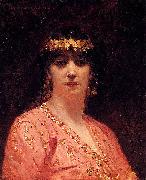 |
Jean-Joseph Benjamin-Constant
|
|
(also known as Benjamin Constant), born Jean-Joseph Constant (10 June 1845 - 26 May 1902), was a French painter and etcher best known for his Oriental subjects and portraits.
Benjamin-Constant was born in Paris. He studied at the Ecole des Beaux-Arts in Paris, where he was a pupil of Alexandre Cabanel. A journey to Morocco in 1872 strongly influenced his early artistic development and lead him to produce Romantic scenes under the spell of Orientalism. Among his noted works in this vein are Last Rebels, Justice in the Harem (both in the Luxembourg Gallery), Les Cherifas, and Moroccan Prisoners (Bordeaux). His large canvas, The Entrance of Mahomet II into Constantinople (Toulouse Museum), received a medal in 1876.
After 1880, he changed his manner, devoting himself to mural decorations and to portraits. Prominent examples include the great plafond in the Hôtel de Ville, Paris, entitled Paris Convening the World; his paintings in the New Sorbonne, representing Literature, The Sciences, and the Academy of Paris; and the plafond of the Opera Comique theatre. He was distinguished as a portrait painter, especially in England, where he was a favorite of the aristocracy. His portrait Mons fils Andra (Luxembourg) was awarded a medal of honor at the Salon in 1896.
Benjamin-Constant painted Pope Leo XIII, Queen Alexandra of England (1901), Lord John Lumley-Savile, and Henri Blowitz (1902). He was made a member of the Institute in 1893, and was a commander of the Legion of Honor. He visited the United States several times, and painted a number of portraits. The Metropolitan Museum of Art in New York owns a large mural decoration by Benjamin-Constant entitled Justinian in Council.
|
|
 |
Jean-Joseph-Xavier Bidauld
|
|
(1758 - 1846) was a French painter.
A native of the city of Carpentras, Bidauld first studied painting with his elder brother, Jean-Pierre-Xavier, in Lyons. In 1783 he traveled to Paris, there winning the favor of an art dealer and perfume seller named Dulac. This latter subsidized Bidauld's travels in Italy, where for five years he lived in Rome and traveled widely. Most of his contacts within the French artistic community in that city were history painters.
In 1790 Bidauld returned to Paris; in 1791 he entered the Salon for the first time. Thereafter he participated regularly. In 1792 he began receiving official commissions, and in 1823 he became the first landscape painter elected to the Academie des Beaux-Arts. 1825 saw him awarded the Legion d'honneur. His reputation began to decline at about this time; as a member of the Salon jury, he was seen as blocking a new generation of landscape painters from gaining entry. Chief among these was Theodore Rousseau. Bidauld was savaged in the press, and as a result became unable to sell his work. By the time of his death, he was near penury.
|
|
|
|
|
|
|
|
 |
Jean-Louis Hamon
|
|
Plouha 1821 - Saint - Raphael, 1874.
French Academic Painter, 1821-1874.
Studied under Charles Gleyre. |
|
|
|
|
|
|
|
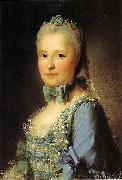 |
Jean-Martial Fredou
|
|
Jean-Martial Fredou (28 January 1710 e 1795) was a French painter known for his portraits.
Born at Fontenay-Saint-Pere, Fredou was attached to the Cabinet du Roi housed in the Hôtel de la Surintendance at Versailles, where he was commissioned to render duplicates of official portraits of the French royal family painted by Jean-Marc Nattier, Maurice Quentin de La Tour, Louis-Michel Van Loo, Alexander Roslin or Joseph Siffred Duplessis.
In his own commissions he often borrowed elements from the original works of these painters, for he was a deft portraitist himself. Between 1760 and 1762 the dauphine Marie-Josephe de Saxe, daughter-in-law of Louis XV commissioned informal portraits of herself and her children, for her own use. These portraits, whether in oil or drawn aux trois crayons, touched with pastels, have freshness and life.
A modest commission came from the Dauphin and Dauphine in 1757: in 1748 they had earth brought in to the little courtyard of their private apartments at the château de Versailles, closed in with trelliswork, to make a little garden; and Fredou was commissiomed to paint two perspective panels to enlarge the little space.[1]
Fredou was never made a member of the Academie Royale de Peinture et de Sculpture, but he was made First Painter to the comte de Provence in 1776 upon the death of François-Hubert Drouais.
|
|
|
|
|
|
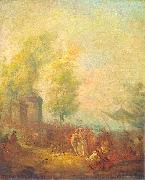 |
Jean-Pierre Norblin de La Gourdaine
|
|
(in Polish, Jan Piotr Norblin; 15 July 1745 - 23 February 1830) was a French-born painter, draughtsman, engraver, drawing artist and caricaturist. From 1774 to 1804 he resided in the Polish-Lithuanian Commonwealth, where he obtained citizenship.
He is considered one of the most important painters of the Polish Enlightenment. He achieved great success in Poland. Given many commissions from some of the most notable families of the Polish-Lithuanian Commonwealth, he stayed there for many years, not returning to Paris until the early 19th century. His style showed the influence of Antoine Watteau, and combined the Rococo tradition of charming fates galantes and fetes champetres with a panorama of daily life and current political events, captured with journalistic accuracy. He created a gallery of portraits of representatives of all social classes in the last years of the Polish-Lithuanian Commonwealth.
|
|
|
|
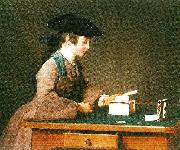 |
jean-simeon chardin
|
|
Jean-Baptiste-Simeon Chardin, född 2 november 1699 i Paris, död 6 december 1779 i Paris, var en fransk målare. Mästare på stilleben och genrebilder.
Chardins blygsamma läggning, personliga stil och valet av motiv från medelklassens vardagsliv försenade hans succe i Bouchers och Fragonards Frankrike, men 1728 invaldes han i Franska akademin samtidigt som hans genrebilder genom gravörernas försorg blev populära.
När 1700-talets hovkonst inte längre var populär, steg Chardins popularitet. De enkla kompositionerna, de ensamma gestalterna i form av köksflickor i arbete eller barn försjunkna i sina lekar, påverkade målare som på 1800-talet målade vardagsmotiv. Manet influerades starkt av den lugna klarheten i Chardins stilleben, liksom Courbet hade påverkats före honom. |
|
|
|
|
|
|
|
|
|
 |
Jehan Georges Vibert
|
|
Jehan Georges Vibert (30 September 1840 - 28 July 1902) was a French academic painter.
He was born in Paris. He began his artistic training at a young age under the instruction of his maternal grandfather, engraver Jean-Pierre-Marie Jazet. Vibert was more interested in painting than engraving and entered the studio of Felix-Joseph Barrias and eventually the École des Beaux-Arts when he was sixteen. He remained at the École for six years under the instruction of historic painter François-Edouard Picot.
Vibert debuted at the Salon of 1863 with La Sieste (The Siesta) and Repentir (Repentance).
During the Franco-Prussian War, Vibert became a sharpshooter and was wounded at the battle of Malmaison in October 1870. He was awarded the Legion deHonneur and became a Chevalier de la Legion deHonneur in recognition of his sacrifice. He became an Officer of the Legion deHonneur in 1882.
|
|
 |
Jeles-Eugene Lenepveu
|
|
French Neoclassical Painter, 1819-1898.
Studied under François-Edward Picot. |
|
|
|
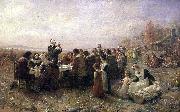 |
Jennie A. Brownscombe
|
|
Jennie Augusta Brownscombe
American, 1850-1936
She has been called "a kind of Norman Rockwell of her era." In fact, the skillful drawing, attention to detail, and nostalgic moods of her paintings make the comparison between Jennie Augusta Brownscombe and the popular American illustrator seem quite apt.
Brownscombe's early life sounds like the story behind one of her own pictures. Born in a log cabin in rural northeastern Pennsylvania, she was the only child of William Brownscombe, an English-born farmer, and Elvira Kennedy, a direct descendant of a Mayflower passenger, who encouraged her young daughter to write poetry and draw. Brownscombe won her first awards as a high school student, exhibiting her work at the Wayne County Fair. When her father died in 1868, Brownscombe began supporting herself through teaching, creating book and magazine illustrations, and selling the rights to reproduce her watercolor and oil paintings as inexpensive prints, Christmas cards, and calendars. More than 100 of Brownscombe's works were distributed this way, spreading her images into homes throughout the nation. |
|
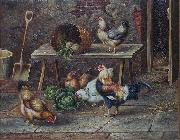 |
Jenny Hoppe
|
|
Jenny Hoppe (Dusseldorf, 1870 -Elsene, 1934) was een Duits-Belgische kunstschilderes.
|
|
|
|
|
|
|
|
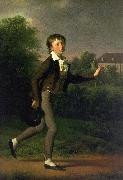 |
Jens Juel
|
|
1745-1802
Danish
Jens Juel Galleries
|
|
|
|
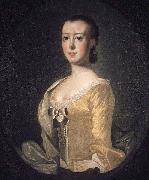 |
Jeremiah Theus
|
|
(April 5, 1716 - May 17, 1774) was a Swiss-born American painter, primarily of portraits. He was active mainly around Charleston, South Carolina, in which city he remained almost without competition for the bulk of his career.
Theus was born in the city of Chur, in the Swiss canton of Graubenden, and was the eldest child of Simeon and Anna Walser Thees. He was nineteen when he immigrated with his family to the Province of South Carolina, whose General Assembly had provided land grants and transport funds to encourage European Protestants to settle in the colony. Simeon Thes was given 250 acres (1.0 km2) of land along the Edisto River in what was then Orangeburgh Township, |
|
|
|
jeremy collier
|
|
1650 C 1726, English clergyman. Collier was imprisoned as one of the nonjurors, who refused to pledge allegiance to William III and Mary II. He later was outlawed (1696) for absolving on the scaffold two of those involved in the assassination plot against William. Collier's principal fame comes from his Short View of the Immorality and Profaneness of the English Stage (1698) and Ecclesiastical History of Great Britain (1708, 1714). In 1713 he was ordained a nonjuring bishop. |
|
 |
Jerg Ratgeb
|
|
Jerg Ratgeb (also Jörg) (born circa 1480 in Schwäbisch Gmend; died 1526 in Pforzheim) was a German painter and contemporary of Derer.
Around the turn of the 15th to 16th century, Ratgeb appears to have spent time in Italy, where he came in contact with Italian Renaissance art and with the recently developed use of perspective in painting. After returning to Germany, he settled in Heilbronn. In 1510, he painted the altar of Saint Barbara in the church of nearby Schwaigern.
From 1514 to 1517 he was in Frankfurt am Main, where he painted the walls of the refectory and cloister of the Karmeliterkloster (Carmelite Monastery). The paintings, of which only fragments survive, are the largest wall paintings known to the north of the Alps from that period. His most famous work is the Herrenberg Altarpiece, completed in 1521. It was originally painted for the Stiftskirche (abbey church) of Herrenberg. Today, it is on display in the Staatgalerie at Stuttgart. Ratgeb had developed a distinctive personal expressive style, visibly influenced by artists such as Albrecht Derer, Matthias Grenewald and Hieronymus Bosch.
Fresco in the Karmeliterkloster, Frankfurt am Main.
Copy of the altarpiece in the abbey church at Herrenberg - here depicted when closed
Because of his marriage with a serf of the Duke of Werttemberg he lost most of his rights as a citizen of Heilbronn. He moved to Stuttgart, where he became a member of the city council. In that position, he negotiated with the rebelling farmers during the German Peasants' War in 1525. He became part of the military contingent requested by the rebels and was elected councillor and chancellor by the peasants. After the suppression of the rebellion, he was arrested, accused of high treason ("because of the Peasant War and on behalf of Duke Ulrich") and finally executed in Pforzheim in 1526, by being torn apart by four horses. |
|
|
|
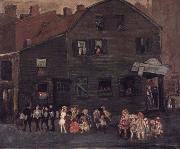 |
Jerome Myers
|
|
(March 20, 1867 - June 19, 1940) was a U.S. artist and writer. Born in Petersburg, Virginia and raised in Philadelphia, Trenton and Baltimore, he spent his adult life in New York City. Jerome worked briefly as an actor and scene painter, then studied art at Cooper Union and the Art Students League where his main teacher was George de Forest Brush. In 1896 and 1914, he was in Paris, but his main classroom was the streets of New York's lower East Side. His strong interest and feelings for the new immigrants and their life resulted in hundreds of drawings, as well as paintings and etchings capturing the whole panorama of their lives as found outside of the crowded tenements which were their first homes in America. |
|
|
|
|
|
|







